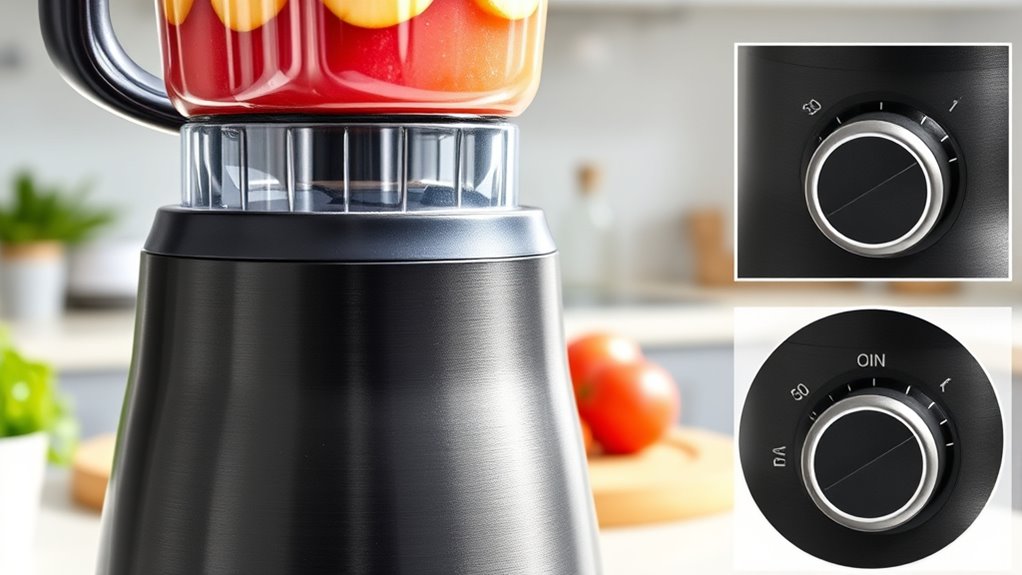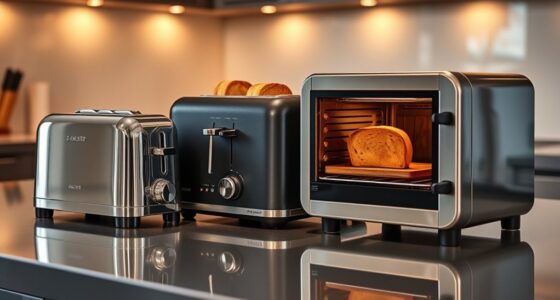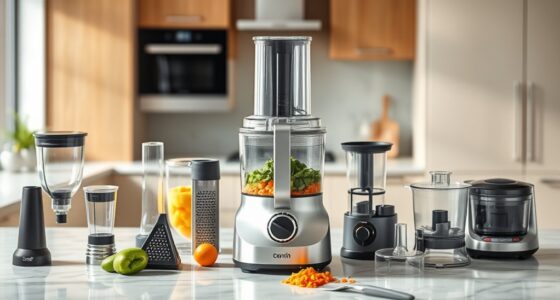When choosing a blender, understand that motor power is key. Wattage indicates the overall capacity, with higher watts handling tougher ingredients like ice and nuts better. Peak horsepower shows your blender’s startup power, while rated horsepower reflects continuous, safe operation. Faster blades at higher RPMs improve blending, but beware of heat from powerful motors, which could cause overheating. Keep these factors in mind, and you’ll pick the right blender—more tips follow to help you succeed.
Key Takeaways
- Higher wattage and rated horsepower indicate better ability to handle tough ingredients like ice and nuts.
- Peak horsepower shows maximum startup power, but rated HP reflects continuous, safe operation for durability.
- Motor power affects blending speed, texture, and efficiency—more power generally means faster, smoother results.
- Blenders with ≥1500W can generate significant heat; use short cycles to prevent overheating and ensure safety.
- Match motor power with pitcher design and task complexity for optimal blending performance and longevity.
Understanding Blender Power Ratings: Watts, Peak HP, and Rated HP
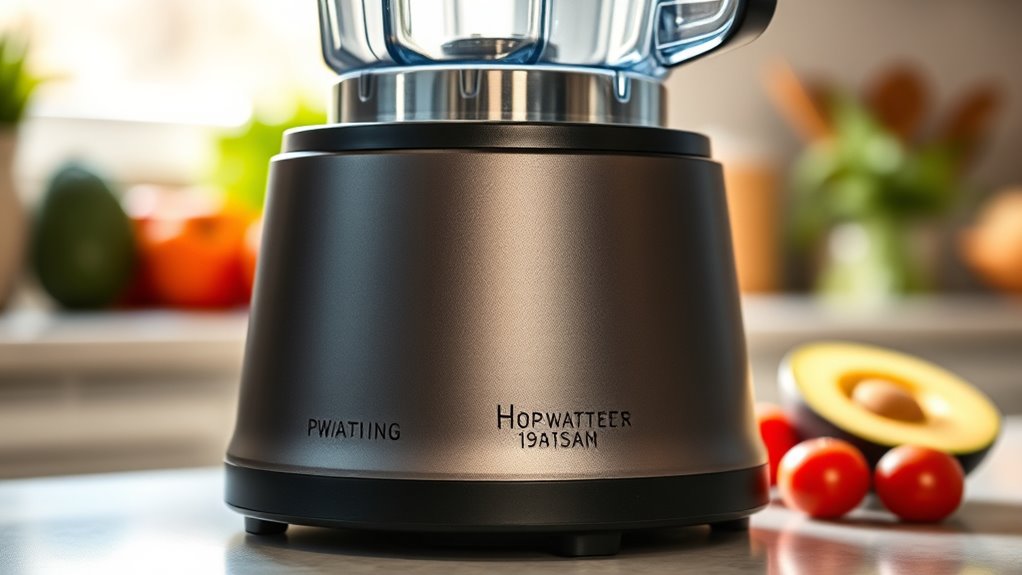
Understanding blender power ratings can seem confusing at first, but knowing what watts, peak horsepower, and rated horsepower mean helps you choose a better appliance. Power ratings indicate motor strength and influence blending capacity. Wattage, often listed as a surge or peak number, shows the maximum power the motor can briefly handle but doesn’t reflect consistent performance. Peak horsepower (Peak HP) represents the maximum power at startup, which is short-lived. Rated horsepower (Rated HP), on the other hand, shows the motor’s continuous, safe operating power, giving a more accurate measure of what the blender can handle during regular use. Higher wattage and rated horsepower typically mean better ability to crush ice and process tough ingredients, helping you pick a blender that meets your blending needs efficiently. Additionally, understanding motor performance can help you select a blender that provides consistent results for your daily tasks.
How Motor Power Affects Blending Performance and Efficiency
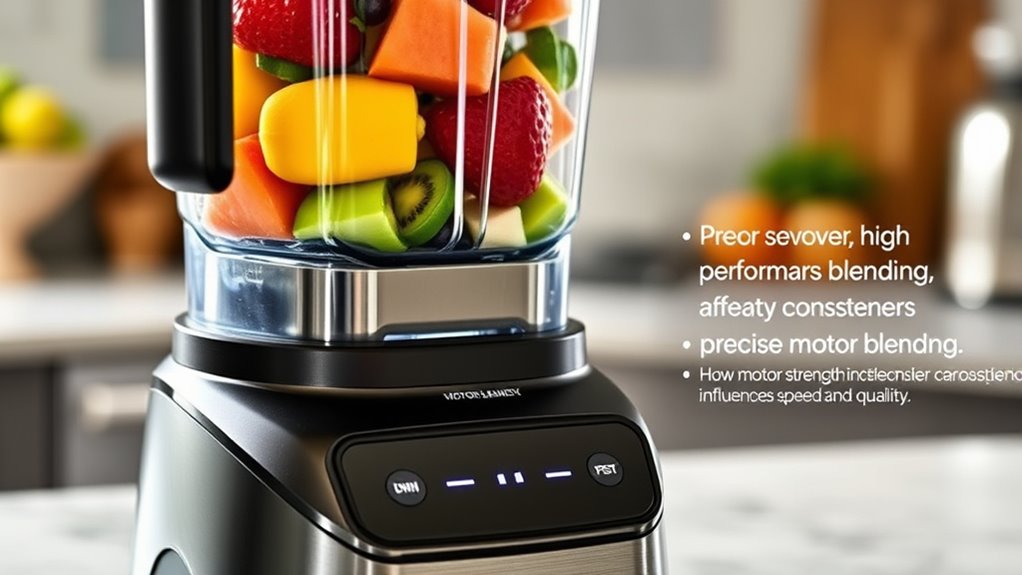
Higher motor power directly boosts your blender’s ability to handle tough ingredients like ice and nuts, making your blending faster and more effective. A powerful motor, measured in wattage, spins blades faster and with more torque, improving blending performance and texture. Here’s how motor power impacts your blender: 1. Higher wattage means better capacity to crush ice and grind nuts without blades stopping. 2. A powerful motor reduces blending time, increasing efficiency. 3. Greater motor power improves overall performance, especially with dense ingredients. 4. Proper design, including blade shape and container, helps maximize the benefits of a powerful motor. Additionally, understanding how essential oils for respiratory health can benefit your well-being highlights the importance of choosing the right tools and ingredients for optimal results. Recognizing the role of AI in cybersecurity can also help protect your data and devices while using smart kitchen appliances. Selecting accessories like blender jars and blades designed for high-powered motors can further enhance your blending experience. Moreover, motor tuning techniques from Honda’s automotive modifications demonstrate how optimizing motor performance can lead to superior results across different applications. For example, cooling systems help maintain motor efficiency and longevity during intensive use.
The Significance of RPM and Blade Speed in Choosing a Blender
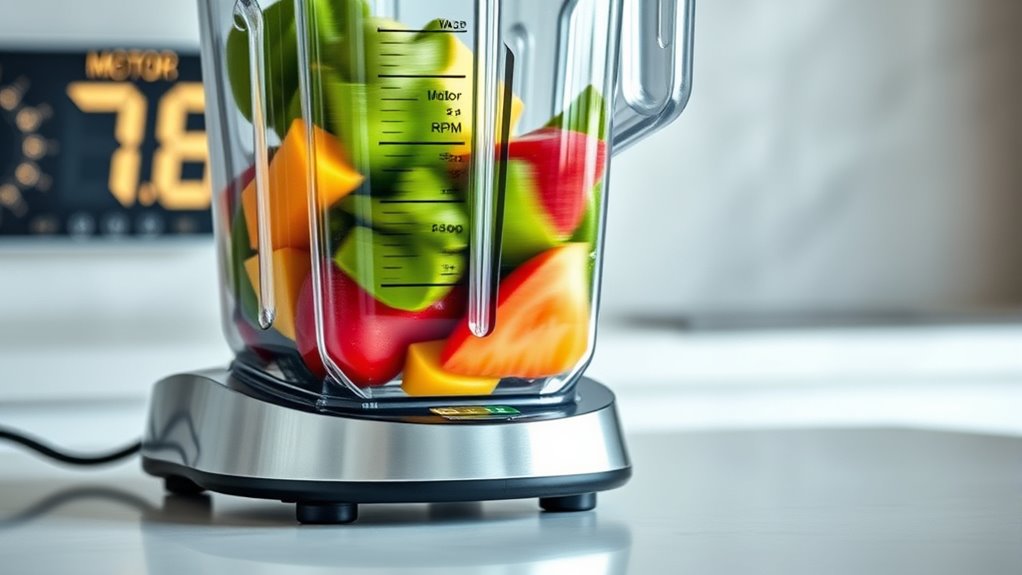
The speed at which blender blades spin, measured in RPM, plays a crucial role in how effectively your blender processes ingredients. Higher RPMs, like 25,000, can boost blade speed, improving tasks like ice crushing and achieving smooth textures. However, RPM alone doesn’t determine blending performance; blade design and motor power also matter. A well-designed blade can enhance blending efficiency even at lower RPMs, while a powerful motor helps maintain consistent blade speed under load. Faster blade speeds generate friction heat, so considering RPM in conjunction with blade sharpness and container shape ensures optimal results. Additionally, motor power influences how well a blender can sustain high RPMs without bogging down under heavy loads. The heat generation from high-speed blending can affect the quality of certain ingredients, making it important to balance speed with thermal considerations. Proper blade sharpness contributes significantly to efficient blending and minimizes strain on the motor. When selecting a blender, understanding the relationship between RPM and motor capacity helps you choose a model capable of handling your specific blending tasks without compromise. Ultimately, understanding RPM and blade speed helps you choose a blender that balances power, design, and performance for your blending needs.
Heat Generation and Safety Considerations With Powerful Blenders
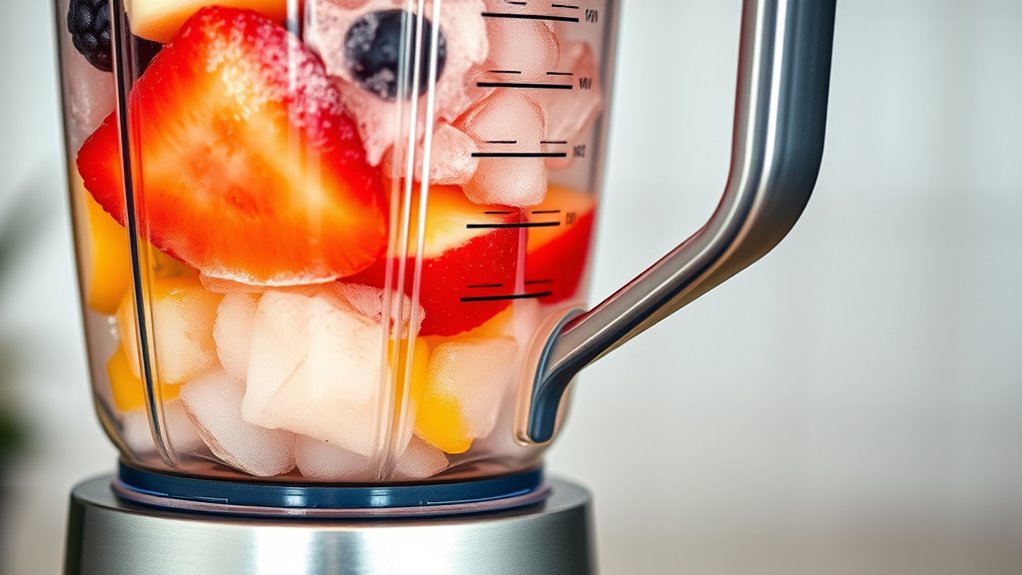
Powerful blenders with motors of 1500W or more can generate significant friction heat during continuous operation, sometimes enough to boil water in just a few minutes. This heat generation raises safety considerations, as high friction heat can cause ingredients to overheat and pose burn risks. To guarantee blending safety, keep these points in mind:
- Avoid prolonged blending at maximum speed to prevent motor overheating.
- Use short, controlled blending cycles, allowing cooling periods in between.
- Be aware that friction heat can raise liquids over 200°F, risking burns or ingredient degradation.
- Monitor your blender during heavy use, and never ignore signs of overheating or unusual noise.
- The contrast ratio of your blender’s motor and blade design can influence how much heat is produced during operation. Additionally, heat dissipation methods play a crucial role in managing motor temperature and ensuring safe operation.
- Proper cooling techniques and regular maintenance can help reduce the risk of overheating and extend the lifespan of your blender. Understanding the motor power and its effects on heat generation helps you operate your blender safely and prolong its lifespan. For example, ventilation around the motor can significantly impact how efficiently heat is dispersed during intense blending sessions.
Practical Tips for Selecting the Right Blender Based on Power and Design
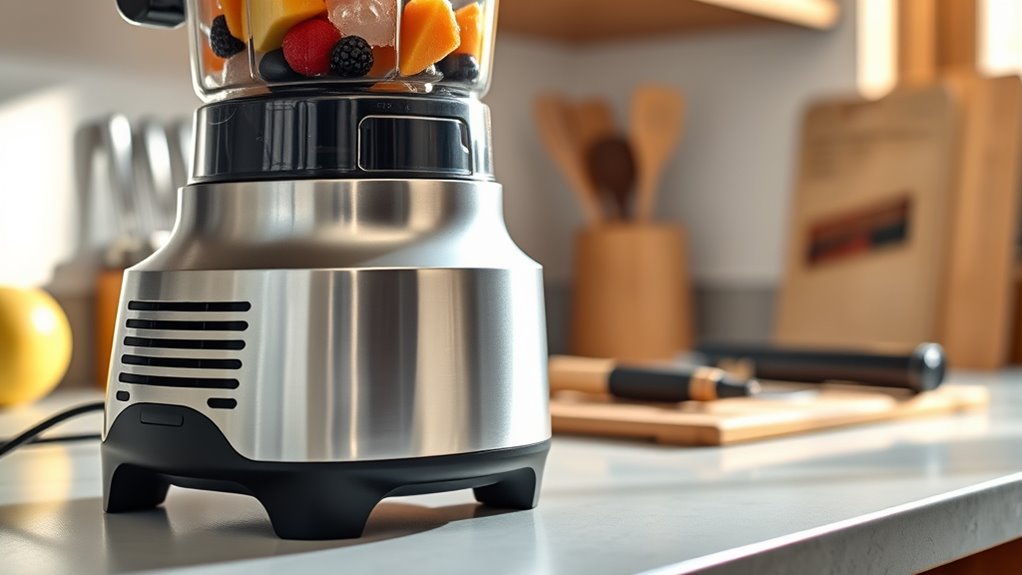
Selecting the right blender involves matching its motor power and design to your specific blending needs. For basic tasks like pureeing fruits and vegetables, choose a blender with at least 500W. If you plan to crush ice or grind nuts, look for a model with 1000W or more, ensuring efficient blending of different ingredients into smaller pieces. Consider the shape of the blender pitchers; square or baffle-equipped containers improve solid blending, especially with high-power motors. Remember, lighter tasks can be handled by blenders with 300-400W, while tougher jobs demand 1000W+ for ideal results. Always verify that the pitcher shape and motor power align, ensuring your best blender can handle the toughest ingredients smoothly and effectively. Additionally, understanding ethical hacking principles can help you protect your online data from malicious attacks. Incorporating ergonomic designs in your blender choice can also enhance comfort during use and reduce fatigue. A Vetted electric bike conversion kit with a powerful motor can enhance your ride experience, just as choosing the right blender ensures optimal performance. Moreover, paying attention to motor durability can ensure your blender maintains performance over time and handles frequent use without issue.
Frequently Asked Questions
What Determines the Power of a Blender?
You determine a blender’s power mainly by looking at its motor wattage and horsepower. A higher wattage (like 1000W or more) means better strength for tough tasks like crushing ice or grinding nuts. Horsepower, which is derived from watts, gives you an idea of the motor’s continuous work capacity. Keep in mind, blade design and container shape also affect how well the motor power translates into blending performance.
How Powerful Is a Blender Motor?
In the age of the Renaissance, craftsmanship mattered greatly, and the same applies to blender motors today. You might wonder how powerful a blender motor truly is. Well, it ranges from 300W to over 1500W. A 600W motor handles smoothies easily, but if you need to crush ice or tough ingredients, look for 1000W or more. Wattage directly shows how well your blender can process hard or soft foods.
What Voltage Is a Blender Motor?
You’re probably wondering what voltage a blender motor runs on. Most household blenders in North America operate on 110-120V, while many in Europe and Asia use 220-240V. Check your blender’s label to confirm its voltage requirements, especially if you plan to travel or buy a new one. Using the right voltage guarantees your blender functions effectively and prevents damage. Always verify compatibility before plugging in.
How to Know if a Blender Is Powerful?
To know if a blender is powerful, check its motor wattage—aim for at least 700W, with 1000W ideal for tough ingredients. Look at the rated horsepower (HP); 1 HP equals 746W, so higher HP means more power. Also, consider RPM speeds and read reviews to see how well it handles challenging tasks. Combining these factors helps you choose a blender that truly meets your blending needs.
Conclusion
Now that you understand how motor power shapes your blender’s performance, you can confidently choose the perfect one. Imagine effortlessly blending icy fruits into silky smoothies or crushing nuts with ease, all thanks to the right motor strength. With this knowledge, you’ll avoid the noisy, sluggish models and find a blender that’s a true kitchen powerhouse. Get ready to blend your way to delicious perfection—powerfully, safely, and effortlessly.
